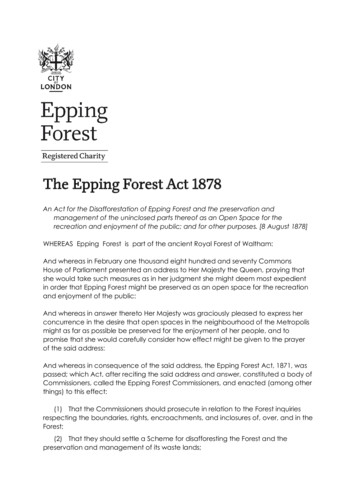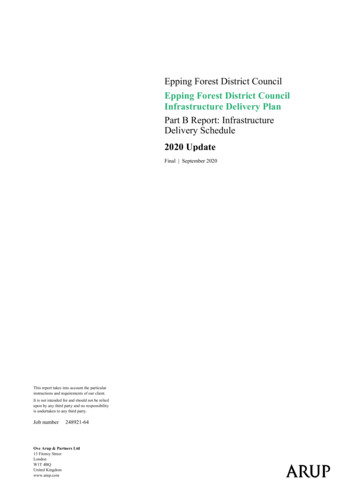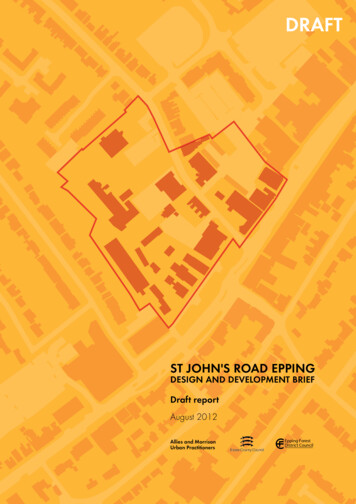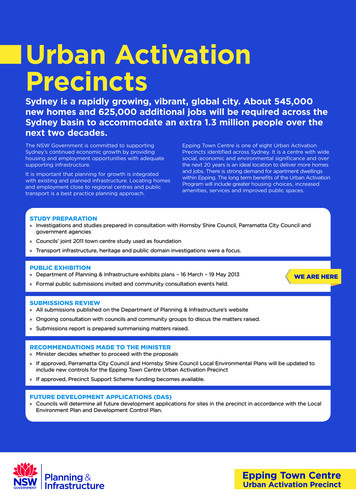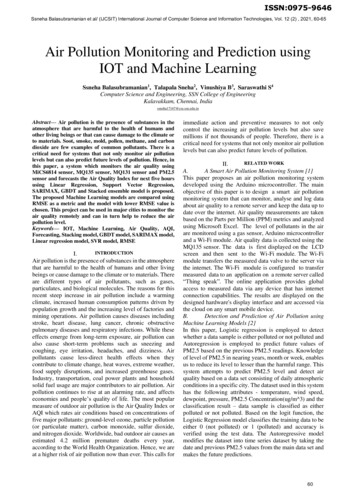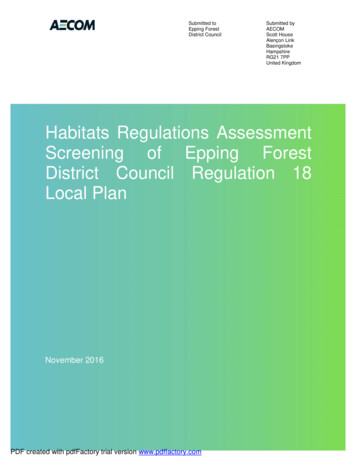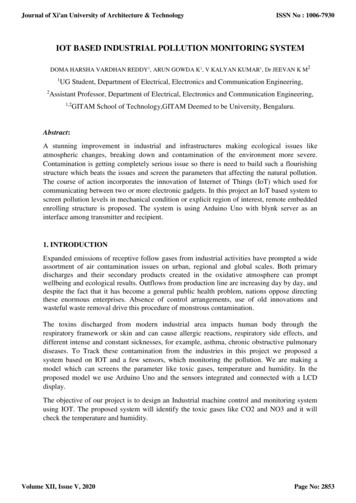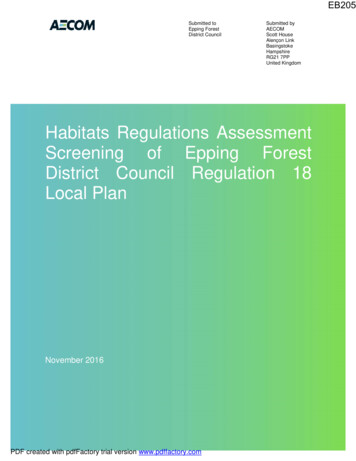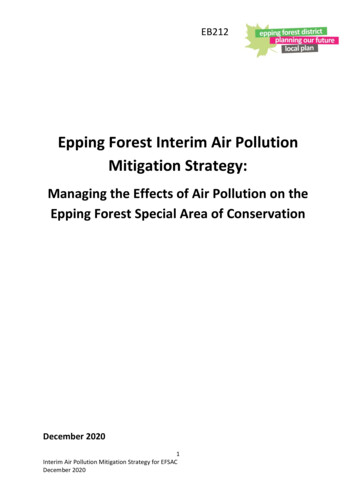
Transcription
EB212Epping Forest Interim Air PollutionMitigation Strategy:Managing the Effects of Air Pollution on theEpping Forest Special Area of ConservationDecember 20201Interim Air Pollution Mitigation Strategy for EFSACDecember 2020
1.Introduction1.1Large parts of the Epping Forest have been designated as a Special Area of Conservation(SAC) because of the significance of its ecological features (known as ‘qualifying features’),specifically its beech forest, wet and dry heaths and population of stag beetle. SACs areinternational designations and have the highest level of protection afforded to them throughUK legislation and Government policy. It is known that much of the Epping Forest SAC is inan unfavourable condition.1.2Under UK legislation Epping Forest District Council (the Council) is a competent authoritywith a duty to ensure that plans and projects, including the emerging Epping Forest DistrictLocal Plan 2011-2033 (the emerging Local Plan) which is at an advanced stage ofpreparation), have no adverse effect on the integrity of the Epping Forest SAC either alone,or in combination with other plans and projects. This includes not doing anything thatwould prevent the Epping Forest SAC from achieving the conservation objectives identifiedfor it. As part of that responsibility the Council, as local planning authority, is required toundertake a Habitats Regulations Assessment (HRA) of the emerging Local Plan.1.3This Strategy has been developed to provide a strategic approach to mitigating the effects ofdevelopment on the integrity of the Epping Forest SAC in relation to atmospheric pollution.It has been developed to support the implementation of policies contained within theemerging Local Plan and specifically policies DM2 and DM22. In doing so it reflects theevidence base (the evidence) developed to support the HRA process. This Strategy willtherefore support the conclusion of the Local Plan HRA process and facilitate thedetermination of individual planning applications which have the potential to have anadverse effect on the integrity of the Epping Forest SAC in relation to atmospheric pollutionwithout mitigation.1.4It is clear from the evidence that without appropriate mitigation development proposedthrough the emerging Local Plan, in combination with other plans and projects, would havean adverse effect on the integrity of the Epping Forest SAC as a result of atmosphericpollution. A key contributor to that atmospheric pollution arises from vehicles.1.5The Epping Forest SAC is bisected by a number of roads which serve communities in EppingForest District and beyond. We know, having undertaken detailed traffic modelling, thatnew development, primarily for housing and employment, will result in increases in trafficon those roads. This traffic modelling has been used to inform air quality modelling, theoutputs of which show that over the period of the emerging Local Plan (covering the periodup to 2033), if no mitigation measures are introduced, air pollution arising from vehicles willhave further harmful effects on the health of the qualifying features within the EppingForest SAC compared to a situation with no growth. It is important to recognise that whilstvehicles are a contributing factor, there are other activities that are also having an adverseimpact on the ecological health of the Epping Forest SAC. Appendix 1 to this Strategy2Interim Air Pollution Mitigation Strategy for EFSACDecember 2020
identifies a number of actions that the Council could take to reduce the contribution thatthese activities have on the Epping Forest SAC.1.6This Strategy has been developed in response to the findings of the evidence base by settingout a suite of mitigation measures that are needed to address the effects of atmosphericpollution arising primarily from new development proposed to be brought forward withinthe District. It is therefore an important part of the evidence base that supports theemerging Local Plan. The Strategy also sets out how these mitigation measures will beimplemented and how the efficacy of those mitigation measures will be monitored andreviewed.2.The evidence base2.1To support an understanding of the likely significant effects of the emerging Local Plan onthe Epping Forest SAC bespoke traffic and air quality modelling has been undertaken basedon observed data and on-site monitoring. As such a robust approach has been undertakento understanding the issues arising from development within Epping Forest District (EFD).The technical notes explaining the methodology undertaken and the results used to informthe development of this Strategy and the emerging HRA can be viewed here (insert link).2.2The predicted change in vehicle flows and mean maximum queue length and duration wasmodelled on a series of roads in close proximity to the Epping Forest SAC. This took accountof all expected growth over the plan period, including Local Plan development and extantplanning permissions, background traffic growth arising from development in surroundinglocal authority areas (including extant planning permissions) and predicted backgroundgrowth in traffic generally as derived by national traffic growth projections. The level ofgrowth applied within EFD arising from the emerging Local Plan has had regard to the advicenote of the Inspector examining the emerging Local Plan dated 2 August 2019.2.3The roads were selected in consultation with the Conservators of Epping Forest and wereconsidered to be those most likely to experience the greatest change in flows (and thereforeimpact) due to the proposed housing and employment growth within and outwith theDistrict for the period to 2033. The modelled network is shown in Figure 1 below.Figure 1: The modelled road links3Interim Air Pollution Mitigation Strategy for EFSACDecember 2020
2.4Using the generated traffic scenarios, information on the vehicle fleet mix, average vehiclespeeds and queue lengths (all of which influence the emissions profile), air quality specialistscalculated expected concentrations, for oxides of nitrogen and ammonia as well as nitrogendeposition rates for the modelled links. For some road sections (particularly around WakeArms Roundabout) multiple transects were modelled in order to capture the effects ofqueuing traffic. The modelled links are depicted in Figure 2 below.Figure 2: Links modelled for air quality purposes3.The Issue3.1The main pollutants of concern for European sites are oxides of nitrogen (NOx), ammonia(NH3) and sulphur dioxide (SO2). Ammonia can also have a direct toxic effect uponvegetation and research suggests that this may also be true for NOx at high concentrationsor in the presence of equivalent amounts of sulphur dioxide. In particular, greater NOx orammonia concentrations within the atmosphere will lead to greater rates of nitrogendeposition to vegetation and soils. An increase in the deposition of nitrogen from theatmosphere is generally regarded to lead to an increase in soil fertility, which can have aserious deleterious effect on the quality of semi-natural, nitrogen-limited terrestrialhabitats. Ammonia and nitrogen can also have a serious deleterious effect on lichens whichtake their nutrients directly from the atmosphere.4Interim Air Pollution Mitigation Strategy for EFSACDecember 2020
Table 1: Main sources and effects of air pollutants on habitats and speciesPollutantSourceEffects on Habitats and SpeciesAcidSO2, NOx and ammonia allCan affect habitats and speciesDeposition contribute to acid deposition.through both wet (acid rain) and dryAlthough future trends in SO2deposition. Some sites will be more atemissions and subsequentrisk than others depending on soildeposition to terrestrial andtype, bed rock geology, weatheringaquatic ecosystems will continuerate and buffering capacity.to decline, it is possible thatincreased ammonia emissions maycancel out any gains produced byreduced SO2 levels.Ammonia Ammonia is released followingAdverse effects are as a result of(NH3 )decomposition and volatilisation of direct toxicity and from nitrogenanimal wastes. It is a naturallydeposition leading to eutrophication.occurring trace gas, but levels have As emissions mostly occur at groundincreased considerably withlevel in the rural environment andexpansion in numbers ofNH3 is rapidly deposited, some of theagricultural livestock. Vehiclesmost acute problems of NH3fitted with catalytic convertors,deposition are for close to thesuch as petrol cars, are also aroadside or close to point sources inknown source of ammonia.intensive agricultural landscapes.Ammonia reacts with acidpollutants such as the products ofSO2 and NOx emissions to producefine ammonium (NH4 ) containing aerosol which may betransferred much longer distances(can therefore be a significanttransboundary issue.)NitrogenNitrogen oxides are mostlyDeposition of nitrogen compoundsoxidesproduced in combustion processes. (nitrates (NO3), nitrogen dioxide (NO2)(NOx)About one quarter of the UK’sand nitric acid (HNO3) can lead toemissions are from power stations, both soil and freshwater acidification.one-half from motor vehicles, andIn addition, NOx can causethe rest from other industrial andeutrophication of soils and water.domestic combustion processes.This alters the species composition ofplant communities and can eliminatesensitive speciesNitrogenThe pollutants that contribute toSpecies-rich plant communities with(N)nitrogen deposition derive mainlyrelatively high proportions of slowdeposition from NOx and NH3 emissions.growing perennial species andThese pollutants causebryophytes are most at risk from Nacidification (see also acideutrophication, due to its promotionof competitive and invasive species5Interim Air Pollution Mitigation Strategy for EFSACDecember 2020
deposition) as well aseutrophication.SulphurDioxide(SO2)Main sources of SO2 emissions areelectricity generation, industry anddomestic fuel combustion. Mayalso arise from shipping andincreased atmosphericconcentrations in busy ports. TotalSO2 emissions have decreasedsubstantially in the UK since the1980s – UK emissions in 2018decreased by 96% relative to 1990,below the 2020 NECD andGothenburg emission targets1.which can respond readily to elevatedlevels of N. N deposition can alsoincrease the risk of damage fromabiotic factors, e.g. drought and frost.Wet and dry deposition of SO2acidifies soils and freshwater, andalters the species composition ofplant and associated animalcommunities. The significance ofimpacts depends on levels ofdeposition and the buffering capacityof soils3.2The Epping Forest SAC is known to be adversely affected by relatively poor local air qualityalongside the roads that run through it and this has been demonstrated to have negativelyaffected the epiphytic lichen communities of the woodland. The nature of the road networkaround the modelled part of the Epping Forest SAC is such that journeys between a numberof key settlements around the Forest by car, van, lorry or bus effectively need to use roadsthat bisect the Epping Forest SAC. Moreover, queues are known to build up around mostarms of the Wake Arms Roundabout, primarily during the AM and PM peak, which increasesemissions compared to the same volume and composition of free-flowing traffic.3.3As such, emissions from road traffic have been the focus of the air quality modelling.Regulations control the sulphur content of fuel used by vehicles, therefore emissions of SO2have not been assessed. Emissions of NOx from road traffic are decreasing due to theimplementation of tighter European type approval standards (Euro Standards). However,ammonia is produced by the control systems that are designed to reduce emissions of NOxfrom road traffic vehicles. Emissions of ammonia are greater from petrol than from dieselcars, whilst the converse is generally the case for NOx. The critical levels for NOx andammonia and the critical load for nitrogen deposition are set out below:PollutantOxides of nitrogen(NOx)Ammonia (NH3)Nitrogen depositionCritical Level30 micrograms per cubicmetre (30µgm-3)1 microgram per cubicmetre (1µgm-3)N/A1Critical LoadN/AN/A10-20 kilograms of nitrogen perhectare per year (10 kg N/ha/yr)UK Informative Inventory Report (1990 to 2018) - s/cat07/2003131327 GB IIR 2020 v1.0.pdf6Interim Air Pollution Mitigation Strategy for EFSACDecember 2020
3.4The plan showing the Transects that have been modelled are set out in Figure 2 above. Theevidence shows that the contributions of NOx, ammonia and nitrogen deposition at theroadside represent a risk to the qualifying features for which the Epping Forest SAC has beendesignated.3.5The outputs of modelling undertaken showed that growth in Epping Forest District up to2033 (i.e. the end of the Local Plan period) is the primary source of additional ammonia andNOx emissions on the modelled road sections and all other plans and projects would appearto make a negligible contribution to the ‘in combination’ effect. This is thought to bebecause the average daily traffic flow on all the modelled sections of road is dominated bypeople who either live or work in Epping Forest District, particularly the settlements thatsurround the Epping Forest SAC, including Epping itself.3.6The evidence demonstrates that the effects of Local Plan development on air quality on theForest will require mitigation measures to be implemented. Some of the required measureswill not only help to avoid adverse impacts of development on the Epping Forest SAC, butalso support objectives including responding to the climate change crisis, managing theeffects of growth on the highway network and supporting healthy lifestyles.3.7The measures contained within this Strategy will be secured through a number ofmechanisms including: the use of planning conditions and/or legal agreements to secure financial contributionsfor the implementation of off-site measures as part of the determination of planningand other development related applications;the development of strategic Masterplans; andstrategic initiatives to be implemented by the Council and its partners.3.8The policy context against which planning and other development related applications willbe assessed in relation to addressing atmospheric pollution is set out in Section 4 below. Inparticular polices DM2 and DM22 provide the Framework by which the effects on the EppingForest SAC will be mitigated to such an extent that an adverse effect on site integrity can beavoided. The measures relied upon to avoid adverse effects to the Epping Forest will besecured through the implementation of this Strategy, which identifies a number of measuresthat will be need to be delivered over the course of the Local Plan period. Appendix 3 to thisstrategy provides a summary of the measures that will be delivered, how they will bedelivered, and when.3.9There are other actions the Council can take, outside of the planning regime, which can alsosupport the management of air quality both across the District and within the Epping ForestSAC. These are set out in Appendix 1 to this strategy. Consequently, this Air PollutionMitigation Strategy brings together all of the proposed approaches to support theimprovement of air quality in the District. Whilst this is primarily to avoid any adverseeffects on the integrity of the Epping Forest Special Area of Conservation, it will also havewider benefits including in relation to peoples’ health.7Interim Air Pollution Mitigation Strategy for EFSACDecember 2020
4.Planning Policy Framework4.1The following policies within the emerging Local Plan are of relevance to achieving, eitherdirectly or indirectly, a positive contribution to atmospheric improvements.Policy SP1 Spatial Development Strategy4.2Policy SP1 sets out the sequential approach to the location of development with a focus onlocations which have access to existing infrastructure, or where there is the greatestopportunity to provide additional infrastructure capacity, including in order to secure amodal shift away from the use of the private car. Both traffic modelling and HabitatsRegulations Assessments were used to inform the approach taken. In addition, theallocation of a number of strategic employment sites in locations where new homes are alsoproposed provides the greatest opportunity to provide an alternative to the private car interms of journey choice and therefore reduce the harmful effects that traffic emissions haveon both ecological and human health.Policy DM2 Epping Forest SAC and the Lee Valley SPA4.3Policy DM 2 sets out the Council’s expectations that all relevant development proposalsassist in the conservation and enhancement of the biodiversity, character, appearance andlandscape setting of the Epping Forest SAC. It contains specific reference to a number ofStrategies, including this Strategy, adopted by the Council as a material consideration in thedetermination of planning applications to ensure that any adverse effects on the integrity ofthe Epping Forest SAC are avoided. This is a main policy to which this Strategy is linked.Policy DM22 Air Quality:4.4This policy seeks to ensure that both the residents and ecological assets of the District,including the Epping Forest SAC, are protected from the impacts of atmospheric pollution.The policy and supporting text to Policy DM22 includes a policy link to Policy DM2 and istherefore also a main policy to which this Strategy is linked.Policy T1 Sustainable Transport Choices.4.5This policy sets out the Council’s commitment to: achieve improvements to strategic rail connections and other public transport networksto the wider area; promote transport choice through improvements to public transport services andsupporting infrastructure; provide coherent and direct cycling and walking networks to provide a genuinealternative to the car; facilitate a modal shift and to promote opportunities for sustainable transport modes;and secure the provision of electric vehicle charging points in all new development whichincludes vehicle parking spaces.8Interim Air Pollution Mitigation Strategy for EFSACDecember 2020
4.6The implementation of Policy T1 is one of the ways in which reductions in atmosphericpollution across the District will be achieved. The supporting text to Policy T1 of theemerging Local Plan explains that the sustainable transport policies seek to widen the choiceof travel opportunities using public transport, walking and cycling. It states that theemerging Local Plan will ensure the provision of facilities and services in new strategicdevelopments to provide high levels of self-containment and secure the provision of, orfinancial support for, bus services and walking and cycling facilities. The supporting textexplains that such an approach can be expected to have a wider benefit as it can alsoprovide access to new transport opportunities for existing residents, thus reducing increasesin background traffic growth and reiterates that the Council will require the provision ofelectric vehicle charging points in all new development which includes vehicle parkingspaces. These requirements are also included within relevant site-specific policies in Chapter5 and Part 2 to the emerging Local Plan.4.7The policy requirement for the provision of electric vehicle charging points in all newdevelopments regardless of their proposed use which include the provision of new parkingspaces has two benefits: it ensures that developments can support the growth in electric vehicles without theneed to retrofit such provision in the future; andit provides confidence for people who have not purchased electric vehicles that theycan do so because they can access the necessary infrastructure now.Development proposals will need to be able to demonstrate that all new parking spaces canhave direct access to a charging point.4.8The Council’s Epping Forest District Cycle Action Plan provides a range of specific proposalsfor improving the cycling infrastructure across the District. The Council’s InfrastructureDelivery Plan identifies all of these projects and sets out how these should be fundedthrough the planning process.Policy DM5: Green and Blue Infrastructure4.9This policy provides the framework within which the Council has developed a Green andBlue Infrastructure (GI) Strategy. The GI Strategy supports the provision of suitablealternative natural greenspace, which serve as an interceptor for visitor trips, a largeproportion of which are made by private car, as well as improvements to, and provision ofnew, walking and cycling connections to support sustainable transport choices.Policy DM 21: Local Environmental Impacts, Pollution and Land Contamination.4.10This is a positive development management policy relating to environmental impact,pollution and land contamination. It is a positive policy as it provides for the prevention ofdetrimental impacts as a result of environmental conditions resulting from newdevelopment such as air quality, and provides for the reuse and recycling of buildingmaterials and the use of local products, thus reducing atmospheric pollutants further, andthe use of water resources during the manufacturing process. Whilst traffic is the maincontributor to atmospheric pollution issues there are other generators of air pollution that9Interim Air Pollution Mitigation Strategy for EFSACDecember 2020
need to be considered and which will support, albeit only by a small amount, positiveimprovements to air quality.Policy D5: Communications Infrastructure.4.11This is a development management policy relating to communications infrastructure. It is apositive policy which ensures that developments make provision for high speed internet andtelecommunications. This supports the potential to reduce the need to travel, particularlyduring the morning and evening peak hours and will therefore make a positive contributionto reducing atmospheric pollution.Site-specific policies4.12The emerging Local Plan includes a number of site-specific policies which will support themanagement of, and improvements to, air quality. The site-specific policies vary dependingon the scale of development proposed. The Garden Communities and Strategic Masterplansites in particular provide a key role in reducing the use of private passenger vehiclesincluding through: the delivery of strong local cultural, recreational, social (including health and educationalfacilities where required), local employment and shopping facilities to support the dayto-day needs of residents which are within walkable distance – the ‘self-sufficiency’principle. The provision of sustainable movement and access to local and strategic destinations(including by rail, bus and walking/cycling). The provision of generous, well connected and biodiverse rich green space provision sothat residents do not have to travel by car to be able to access natural green space.4.13These site-specific requirements are key to ensuring the provision of infrastructure tosupport the achievement of a reduction in private car use. In particular there are significantopportunities to secure such infrastructure on the strategic masterplan sites. These largersites also provide the opportunity to ensure that community infrastructure and services andlocal employment opportunities (such as education and health provision, local facilities andservices, and open space) are integrated as part of the design of development. This willprovide opportunities to minimise the use of the private car. These sites will also besupported by the provision of new passenger transport services. Such provision couldprovide wider benefits to existing residents and businesses where current passengertransport services are limited or non-existent.5What we need to achieve by 2033 and how we will get there.5.1There is a need for the Council, as competent authority, to not only provide the planningpolicy framework which ensures that the measures needed to protect the Epping Forest SACare secured, but also identify the specific mitigation measures that need to be deliveredbased on the current evidence and in accordance with the requirements of the HabitatsRegulations.10Interim Air Pollution Mitigation Strategy for EFSACDecember 2020
5.2The evidence base modelled a number of scenarios which assessed future developmentgrowth in the District ‘in combination’ with other plans and projects (i.e. the Local Plan plusgrowth in surrounding authorities). A number of potential measures were initiallyconsidered, including the implementation of a Clean Air Zone encompassing the roads withinclose proximity to the Epping Forest SAC and the closure of roads to HGVs. In additionconsideration was given to what beneficial effects a shift from Large Goods Vehicles (LGVs)to Ultra Low Emission Vehicles (ULEVs or simply newer Euro standards) would have.Ultimately, two approaches were selected as being quantifiable in the air quality modellingand the most likely to be sufficiently effective in order to be able to reach a conclusion of noadverse effect on the integrity of the Epping Forest SAC. These were as follows:1. The introduction of a Clean Air Zone; and2. Increasing the percentage of the vehicle fleet that constitutes ULEVs to 12-15% by 2033,with a focus on the conversion of petrol cars (these being a major source of ammonia) toULEVs (e.g. electric cars).5.3The evidence base provides a detailed understanding of the air pollution context in 2033 andwhat needs to be done in order to reach a conclusion of no adverse effect on the integrity ofthe SAC as a result of new development. This understanding was based on modelling thefollowing: A minimum 10% conversion of petrol cars to ULEVs by 2025, in other words, 4-5% ofthe Epping Forest SAC vehicle fleet to be ULEVs by this year;The introduction of a Clean Air Zone from 2025;A minimum 20% conversion of petrol cars to ULEVs by 2029; (8-10% of the EppingForest vehicle fleet to be ULEVs by this year); andA minimum 30% conversion of petrol cars to ULEVs by 2033 (12-15% of the EppingForest SAC vehicle fleet being ULEVs by this year)The evidence demonstrates that the conversion of petrol cars to ULEVs and the introductionof a Clean Air Zone (CAZ) in 2025 would ensure that planned development would notinterfere with the ability of the Epping Forest SAC to achieve its conservation objectives withregard to Nitrogen Deposition, or ammonia and NOx concentrations.5.4There are other measures which would also have a beneficial role in achieving animprovement in air quality within the Epping Forest SAC and beyond. Consequently themeasures identified within this section are all considered to be necessary to achieve theprimary objective of the delivery of development not adversely affecting the integrity of theEpping Forest SAC. Regular on site air quality and traffic monitoring are also key elements ofthis Strategy so that we can use data which is specific to the Epping Forest SAC to help usunderstand the effectiveness of the measures identified in this Strategy or if we need to lookat other approaches. The approach to monitoring is set out in Section 6 of this Strategy.The outputs will be used to inform the requirement to regularly review the Local Plan and inparticular the indicators set out in Policy D8 of the emerging Local Plan. It is also importantthat this Strategy is reviewed, and if necessary, updated on a regular basis. In part this is to11Interim Air Pollution Mitigation Strategy for EFSACDecember 2020
ensure that it is achieving its objective of improving air quality across the Epping Forest SACbut will also enable consideration to be given to new technologies and other approachesthat may emerge in the future. The remainder of this Section sets out the measures thatneed to be delivered whilst Appendix 3 provides an overview of what will happen when andby who.5.5The introduction of a CAZ covering the SAC from 2025 would involve charging people drivingcertain types of vehicle through the zone based upon the age and type of their vehicle. Theaim is to encourage motorists to replace older vehicles with newer vehicles compliant withthe latest emissions standards, and in particular Ultra-Low Emission Vehicles or ULEVs,through a graduated charging system (for example, zero charge for ULEV owners, or anincreased charge for petrol car owners). It would potentially also encourage those motoristswho were able to, to use other routes instead of using roads in close proximity to the EppingForest SAC. As a precaution no dynamic reassignment has actually been assumed in thetraffic modelling used in the development of the evidence base. A series of measures thatare intended to encourage the uptake of ULEVs to maximise the likelihood of achieving theconversion of 30% of petrol cars using the modelled roads to ULEVs by 2033 include:a) ensuring that the necessary infrastructure for ULEVs is widely and easily available acrossthe District;b) incentivising the replacement of petrol cars with ULEVs, targeted at people who live inareas from which the most frequent trips on roads in close proximity to the Epping ForestSAC arise; andc) Undertaking awareness-raising of both the issue of air pollution and the things thatresidents and businesses can do to contribute to improving air quality.5.6The Council recognises that the implementation of a CAZ will not come without some impacton residents and businesses across the District but it also has a legal responsibility to ensurethat it can support the delivery of new homes and jobs without having an adverse effect onthe integrity of the Epping Forest SAC.5.7It is vital that the Council ensures that robust monitoring is undertaken so that it can beconfident that the implementation of all the measures continues to be ‘fit for purpose’. Thismonitoring will involve the collection of up-to-date traffic and air quality monitoring datafrom across the Epping Forest SAC. As
an adverse effect on the integrity of the Epping Forest SAC as a result of atmospheric pollution. A key contributor to that atmospheric pollution arises from vehicles. 1.5 The Epping Forest SAC is bisected by a number of roads which serve communities in Epping Forest District and beyond. We know, having undertaken detailed traffic modelling, that
